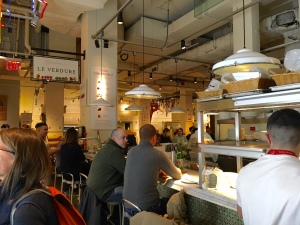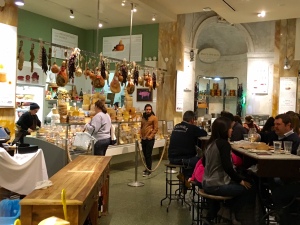Cacio e pepe, literally cheese and pepper, is a dish so simple that it’s hard to get right. Recipes for this dish abound, many of them with as few as three ingredients: pasta, grated pecorino Romano, ground black pepper. Some include butter or olive oil or specify a mix of cheeses—Parmigiano-Reggiano or Grana Padano in addition to the pecorino Romano. All include an additional ingredient: the pasta cooking water.
 We tasted this dish in Rome, in an inexpensive but well-regarded chain restaurant. The dish came to our table, the pasta heaped in the center of a white pasta plate and wafted the heady aroma of the cheese. I don’t know if this restaurant used one cheese or two cheeses or three, if they used butter or olive oil, but their cacio e pepe was a marvel: the pasta the perfect state of toothiness, the black pepper visible and perceptible to taste but not overpowering, the pecorino Romano intensely flavorful.
We tasted this dish in Rome, in an inexpensive but well-regarded chain restaurant. The dish came to our table, the pasta heaped in the center of a white pasta plate and wafted the heady aroma of the cheese. I don’t know if this restaurant used one cheese or two cheeses or three, if they used butter or olive oil, but their cacio e pepe was a marvel: the pasta the perfect state of toothiness, the black pepper visible and perceptible to taste but not overpowering, the pecorino Romano intensely flavorful.
I wanted to go for another plate of cacio e pepe in Rome, this time in a fancier restaurant. I had the perfect place in mind: Ristorante Roma Sparita, the restaurant that, according to Anthony Bourdain, serves the best cacio e pepe in the world. It’s in the Trastevere neighborhood of the city, east of the Tiber River, south of Vatican City, an easy half hour walk from our apartment near the Colosseum.
But events conspired and we were not able to go, and I was not able to get another plate of cacio e pepe. In Florence, I got to try pasta alla gricia, yet another classic pasta dish. Similar to cacio e pepe in its utter simplicity, this one trades the butter with tiny chunks of lightly fried guanciale, an Italian cured meat made with pork jowl. We tried this dish in a neighborhood restaurant and were amazed by how delicious it was. The dish was simple yet absurdly rich, with what I felt were tiny explosions of lush smoky pork fat in my mouth.
 Back in New York, I have become somewhat obsessed with the two pasta dishes and the two ingredients required in both. Pecorino Romano is made from sheep’s milk. It’s hard and crumbly, salty and exceptionally savory. It’s supposed to be one of the most ancient of cheeses, eaten during their marches by the Roman legions and cited by Roman authors like Pliny the Elder and Hippocrates. It’s widely used in cooking, but also wonderful to snack on and robust enough to hold its own when paired with a glass of red wine. (Just the thought of such a snack—slices of the cheese, some grapes, a glass of red wine—makes me happy. Add some crusty bread and good olive oil, and perhaps another glass of wine, and it’s a spare, elegant dinner.)
Back in New York, I have become somewhat obsessed with the two pasta dishes and the two ingredients required in both. Pecorino Romano is made from sheep’s milk. It’s hard and crumbly, salty and exceptionally savory. It’s supposed to be one of the most ancient of cheeses, eaten during their marches by the Roman legions and cited by Roman authors like Pliny the Elder and Hippocrates. It’s widely used in cooking, but also wonderful to snack on and robust enough to hold its own when paired with a glass of red wine. (Just the thought of such a snack—slices of the cheese, some grapes, a glass of red wine—makes me happy. Add some crusty bread and good olive oil, and perhaps another glass of wine, and it’s a spare, elegant dinner.)
The cheese is easily found in New York, available in most markets with a cheese case. It’s not inexpensive, but you use very little of it at a time. You can’t use too much of it, otherwise the dish will become unpalatable—so easily does intense flavor become inedible.
Since coming back from Italy, I’ve tried to cook cacio e pepe but, of course, it never comes out the way the dish tasted or even looked in the restaurant in Rome. Pecorino Romano, it turns out, is hard to cook with—it doesn’t melt easily the way, for example, Parmigiano-Reggiano does. A temperamental ingredient, it clumps up, sticks to the pan, refuses to cooperate with the pasta. A number of solutions are offered in various websites: the addition of butter and eggs, for example, but then the dish becomes almost a carbonara. What seems to work is to whip the grated cheese with the pasta cooking water quickly to emulsify the mixture and to release some of the heat. There seems to be a counter-intuitive principle at work here: the cheese requires gentle heat to melt properly and cling to the pasta.
 Last week I dragged my family to a place in the city called Eataly. It’s a fancy food market curated by the royalty of Italian food in America, Mario Batali and Lidia Bastianich. A sprawling space filled with jams, cookies, candies, cheeses, pastas, and charcuterie from Italy, it also has areas for eating—charcuterie and cheeses in one side, fish and vegetables in another, and pizzas and pastas in another. It has a gelateria, a pastry shop, and two coffee bars. The place is trendy and expensive, beautifully laid out with rustic wood surfaces, marble countertops, gleaming stainless steel details, one of those temples to food porn where a tiny jar of jam costs nine dollars and a pound of artisanal pasta is ten dollars.
Last week I dragged my family to a place in the city called Eataly. It’s a fancy food market curated by the royalty of Italian food in America, Mario Batali and Lidia Bastianich. A sprawling space filled with jams, cookies, candies, cheeses, pastas, and charcuterie from Italy, it also has areas for eating—charcuterie and cheeses in one side, fish and vegetables in another, and pizzas and pastas in another. It has a gelateria, a pastry shop, and two coffee bars. The place is trendy and expensive, beautifully laid out with rustic wood surfaces, marble countertops, gleaming stainless steel details, one of those temples to food porn where a tiny jar of jam costs nine dollars and a pound of artisanal pasta is ten dollars.
 But I was obsessed and needed (yes, it was a need) to be near Italian food items. We went to the pizza and pasta restaurant and ordered two pizzas and a plate of cacio e pepe. The pizzas were terrific. And the cacio e pepe? It came while we were halfway through the two pizzas, carried by a man who did not wear the waiters’ black and white uniform but instead jeans and an untucked plaid shirt. He had a Roman nose, beautiful eyes, a mop of black curly hair. He looked, in other words, as if he was an owner or a manager or some other official Italian food authority.
But I was obsessed and needed (yes, it was a need) to be near Italian food items. We went to the pizza and pasta restaurant and ordered two pizzas and a plate of cacio e pepe. The pizzas were terrific. And the cacio e pepe? It came while we were halfway through the two pizzas, carried by a man who did not wear the waiters’ black and white uniform but instead jeans and an untucked plaid shirt. He had a Roman nose, beautiful eyes, a mop of black curly hair. He looked, in other words, as if he was an owner or a manager or some other official Italian food authority.
As he laid the plate of steaming pasta on our table, however, he asked me, “Would you like some cheese?”
I was mystified. On the one hand, I understood the question: Americans always want more cheese. Even the humblest pizzerias in the country have glass shakers of Parmesan flakes (and we’re not going to debate whether or not that’s cheese at this point). On the other hand, I wanted to eat a professionally cooked plate of this dish exactly because I did not want to think about the amount of cheese the dish required. The dish, it seems to me, is all about balance.
“But doesn’t it already have cheese?” I asked him. “Well, yes,” he said. Then added, “So you can try it and you can always ask for more cheese.”
Dear reader, the cacio e pepe was terrible. The pasta was undercooked instead of al dente, oily instead of rich, tasting one-dimensionally of butter instead of the complex mouth-filling umami of good cheese.
It was disappointing. But I did get to buy guanciale in the market and what looked like a superbly fresh wedge of pecorino Romano. So in my next essay, I’ll write about pasta alla gricia, my other current pasta obsession.





